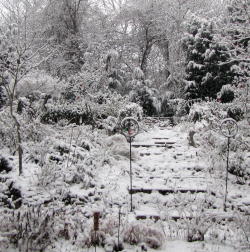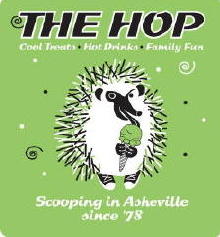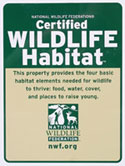On a trip to North Carolina, after we first moved to the present location, a visit was made to a wonderful, now defunct nursery called Herb ‘O Grace. High Tea was offered along with a beautiful mountainside herb garden for casual touring. Plants for sale were unusual and healthy. Several were purchased on multiple visits. Among those was my first heath, an unknown erica darleyensis, blooming a dark purple in late November. It was striking, with dark green needle like foliage and tiny violet red bell shaped flowers. Planted in the wrong place at the bottom of the slope it succumbed in the first year to the wet winter. But research led to an online nursery that specialized in these shrubs, Rock Spray Nursery. Shown above are three little calluna vulgaris ‘Blazeaway” purchased from them in four inch pots.
 Even the big box stores offered the winter blooming varieties of erica darleyensis, ‘Mediterranean Pink’ and ‘Mediterranean White“. The vision was a mass planting of low shrubs in this bed with a specimen magnolia ‘Jane‘ for height. The heaths begin blooming in December, occasionally November here and continue through April. They are not real showy but don’t have to be to stand out during mid winter.
Even the big box stores offered the winter blooming varieties of erica darleyensis, ‘Mediterranean Pink’ and ‘Mediterranean White“. The vision was a mass planting of low shrubs in this bed with a specimen magnolia ‘Jane‘ for height. The heaths begin blooming in December, occasionally November here and continue through April. They are not real showy but don’t have to be to stand out during mid winter.
 I was on the lookout now for any and all heaths and heathers, not really knowing the difference between the two. It has been learned that heathers are callunas, heaths are ericas. The needles of heathers are thicker than the heaths. Most heathers bloom in summer also. The heathers have varieties whose foliage turns different colors in summer, fall and winter. This is calluna vulgaris ‘Red Fred’. There is nothing red about it. Maybe it was mislabeled. It was purchased at a nursery nearby that had been bought out by less knowledgeable entrepreneurs than the original owners. The foliage is an attractive green, the flowers are pink, but I was looking for something to be red.
I was on the lookout now for any and all heaths and heathers, not really knowing the difference between the two. It has been learned that heathers are callunas, heaths are ericas. The needles of heathers are thicker than the heaths. Most heathers bloom in summer also. The heathers have varieties whose foliage turns different colors in summer, fall and winter. This is calluna vulgaris ‘Red Fred’. There is nothing red about it. Maybe it was mislabeled. It was purchased at a nursery nearby that had been bought out by less knowledgeable entrepreneurs than the original owners. The foliage is an attractive green, the flowers are pink, but I was looking for something to be red.
 From Rock Spray were ordered four calluna vulgaris ‘Sunset“s for the knot garden. Their catalog showed pictures of fascinating colorful foliage on certain varieties. Those were incorporated into the vision. More, more more! Also in bloom above are various viola seedlings and dianthus ‘Firewitch’. Blue forget me nots are in the far corner.
From Rock Spray were ordered four calluna vulgaris ‘Sunset“s for the knot garden. Their catalog showed pictures of fascinating colorful foliage on certain varieties. Those were incorporated into the vision. More, more more! Also in bloom above are various viola seedlings and dianthus ‘Firewitch’. Blue forget me nots are in the far corner.
 Another shot of ‘Sunset’ after the first frost of the season, mid October. It still holds the yellow color but will turn to pink then red as the cold continues. Creeping thyme, thymus ‘Doone Valley’ grows at its base.
Another shot of ‘Sunset’ after the first frost of the season, mid October. It still holds the yellow color but will turn to pink then red as the cold continues. Creeping thyme, thymus ‘Doone Valley’ grows at its base.
 A December shot shows the pinky coloration. The bamboo sticks in the center quatrafoil and corner beds are to keep the marauding squirrels from digging there. It seems to help with that, even covered with a thin layer of mulch. There are tulips, crocus and iris reticulata planted in the perimeter beds that the squirrels are attracted to. It is a constant battle to keep the bulbs safe. More about that later.
A December shot shows the pinky coloration. The bamboo sticks in the center quatrafoil and corner beds are to keep the marauding squirrels from digging there. It seems to help with that, even covered with a thin layer of mulch. There are tulips, crocus and iris reticulata planted in the perimeter beds that the squirrels are attracted to. It is a constant battle to keep the bulbs safe. More about that later.
 Calluna vulgaris ‘Firefly’ has a more dense, upright habit than ‘Sunset‘. Several of these line the bed in front of the garage deck. Grape hyacinths, muscari, make a contrasting edging and the blue blooms in spring look lovely, (see Blue in The Garden part three).
Calluna vulgaris ‘Firefly’ has a more dense, upright habit than ‘Sunset‘. Several of these line the bed in front of the garage deck. Grape hyacinths, muscari, make a contrasting edging and the blue blooms in spring look lovely, (see Blue in The Garden part three).
.jpg)








Heaths and heathers . . . it all sounds so romantic. Do you have a Heathcliff too, Frances?
Pam…the romance of the names is reason enough to have these plants in your garden, “Oh do come see the heaths and heathers!” As to Heathcliff, I guess you could call him that. But he probably would not answer to that name. HA.
Need a list of winter plants. Hellebores, heaths, what else?
chickenpoet…anything evergreen , that’s what one looks for. Dianthus, heuchera, thymes, blue fescue are good colorful perennials in winter.
I’m going to have to give the bamboo sticks a try. They are much more attractive than the chickenwire I use to protect newly planted areas from those digging squirrels.
MMD…The chickenwire works much better but there were many existing plants in the beds. There is a combo of bamboo and rebar in between the plantings. New pansies are protected with leftover stones from the rock wall. Bamboo skewers were tried to protect seed plantings but were tossed around like toothpicks.It is an ongoing problem.
just when we think, ‘aww, dawg gonnit, winter’s gon dun kilt my p’rennials,’ here comes the knowledge of showy everygreens that pack as much or more color than some summer flowers. instead of ruminating with leaky eyes that the show is over until march, we post up in front of the computer and search out the wickedest, wildest, gaw blastit heaths and heathers the myriad online nurseries produce. and now we think, ‘shoowie, i tell ya, b’tween erica and calluna my gard’n’s a-gonna be jus’ dag nabbin’ b-yoot-y-ful,’ and we wave with happy pride our winter flags.
brokenbeat…I don’t know exactly what you were saying, but thanks for the comment.
That was pretty funny Brokenbeat.
Love those heathers. I think it’s time for a retry in the herb farm.
semi..yes do try again with the heathers, this time without the mushroom compost. And yes, brokenbeat is quite the comedian.
What a lovely scene with the heathers around the magnolia, Frances.
My gardens have all been on alkaline soil, so the only heathers I’ve grown were annuals in containers, but I do admire them. It’s fun to see your Virginia garden with plants so different from midwest prairies or the heart of Texas.
We do share the marauding squirrels, unfortunately!
Annie at the Transplantable Rose
Annie…Thanks. We have a more acid soil here, but we are in southeast Tennessee. It sounds like the squirrels know no boundaries, by state or region or country.
Frances, I apologize for putting you in the wrong state – it says Tennessee right on the front page of your gardenblog. Sometimes I’m a little flaky ;-]
Annie